January happens to be the month in which some of my all-time favorite people are born. Apart from my oldest kid (6th), my two nephews (7th & 13th), Kathy M. (the -- um whatever last Friday was), and Franklin (sometime this week), today happens to be the birthday of Wolfgang Amadeus Mozart. (Now a few dozen of you are smacking your foreheads, thinking "That explains the Google graphic!")
What does Mozart have to do with knitting?
Nothing really. We don't have any evidence that Mozart knitted, no remnants of a lace pattern on the back of a foolscap score, no crackled oil paintings showing Wolfie with a pair or two of Addi Turbos and some sock yarn. But in a weird way, Mozart's music touches a part of me that is also touched by great knitting.
In many respects, this world sucks. Human beings can be so needlessly cruel, so barbaric, delighting in torturing each other (physically and emotionally). When one encounters "the blood, the horror inherent in life, when one finds darkness not only in one's culture but within oneself,"1 it's a wonder anybody can get out of bed in the morning. But occasionally I catch a glimpse of something beautiful, something breathtakingly lovely that a human being has created: a sonnet, a glorious piece of fair isle, the face in a Renoir painting, a striking piece of architecture, and yes, an exquisite piece of music (or several hundred exquisite pieces of music, in Mozart's case).
Listen to Sonata in C (so simple a beginning piano student could play it), or Eine Kleine Nachtmusik, which you've heard a million times before but is still a wonderful piece of music, or hum "Twinkle, Twinkle, Little Star," for Christ's sake, and be glad that every thousand years or so, somebody is born on this earth with such a profound capacity for creating the beautiful.
1to quote some guy named Barry Lopez.
Friday, January 27, 2006
Tuesday, January 24, 2006
Total Project Cost vs. Cost Per Yard (and after this, no more math for a while)
Okay, just to muddy the waters a wee bit more, I'm going to throw out one more variable to consider when evaluating the economics of knitting. Yesterday I talked about Cost Per Yard, cautioning you to calculate this before deciding whether a yarn is a good buy or not. I also brought to your attention the variable of yarn thickness, demonstrating that thicker may be quicker, but it isn't usually cheaper.
Today we will look at Total Project Cost, or how "put-up" can affect the price of a project.
"Put-up" refers to how a yarn is packaged for sale, usually how many yards are in a ball or hank. Sometimes the put-up will affect your actual cost so that a yarn that may be cheaper per yard is ultimately more expensive in the context of your particular project.
Let's look at two bulky yarns by Cascade: Cascade 128 is put up in 128-yard hanks (get it? that's why it's called "128"); Cascade EcoWool is put up in 475-yard megahanks. Here is Cost Per Yard:
Cascade Eco-Wool: $18 per hank divided by 475 yds. per hank = 3.7 cents per yard
Cascade 128: $9 per hank divided by 128 yds. per hank = 7 cents per yard
Eco-Wool is much cheaper, nearly half as much when measured by Cost Per Yard.
But suppose you want to knit a baby blanket that requires 3 different colors of the same bulky yarn. And suppose the pattern requires 500 yards of Color A and 100 yards of each of Colors B & C. Let's look at the total amount of money you'd have to shell out to buy enough yarn to complete the project:
Cascade Eco Wool
Color A = 2 hanks x $18 = $36
Color B = 1 hank x $18 = $18
Color C = 1 hank x $18 = $18
Total Project Cost: $72
Cascade 128
Color A = 4 hanks x $9 = $36
Color B = 1 hank x $9 = $9
Color C = 1 hank x $9 = $9
Total Project Cost: $54
Because of the large put-up on the EcoWool, and the quirks of the particular project you are making (e.g. one large EcoWool skein isn't quite enough for Color A so you have to buy two, thus ending up with lots of excess yarn in Color A), the yarn that is more expensive per yard ends up being cheaper for this particular project.
Have I totally confused you?
The moral of the story: Do the math. Take a calculator with you or borrow one from your friendly LYS salespeople and figure out Total Project Cost if you have a particular budget in mind for your project.
Today we will look at Total Project Cost, or how "put-up" can affect the price of a project.
"Put-up" refers to how a yarn is packaged for sale, usually how many yards are in a ball or hank. Sometimes the put-up will affect your actual cost so that a yarn that may be cheaper per yard is ultimately more expensive in the context of your particular project.
Let's look at two bulky yarns by Cascade: Cascade 128 is put up in 128-yard hanks (get it? that's why it's called "128"); Cascade EcoWool is put up in 475-yard megahanks. Here is Cost Per Yard:
Cascade Eco-Wool: $18 per hank divided by 475 yds. per hank = 3.7 cents per yard
Cascade 128: $9 per hank divided by 128 yds. per hank = 7 cents per yard
Eco-Wool is much cheaper, nearly half as much when measured by Cost Per Yard.
But suppose you want to knit a baby blanket that requires 3 different colors of the same bulky yarn. And suppose the pattern requires 500 yards of Color A and 100 yards of each of Colors B & C. Let's look at the total amount of money you'd have to shell out to buy enough yarn to complete the project:
Cascade Eco Wool
Color A = 2 hanks x $18 = $36
Color B = 1 hank x $18 = $18
Color C = 1 hank x $18 = $18
Total Project Cost: $72
Cascade 128
Color A = 4 hanks x $9 = $36
Color B = 1 hank x $9 = $9
Color C = 1 hank x $9 = $9
Total Project Cost: $54
Because of the large put-up on the EcoWool, and the quirks of the particular project you are making (e.g. one large EcoWool skein isn't quite enough for Color A so you have to buy two, thus ending up with lots of excess yarn in Color A), the yarn that is more expensive per yard ends up being cheaper for this particular project.
Have I totally confused you?
The moral of the story: Do the math. Take a calculator with you or borrow one from your friendly LYS salespeople and figure out Total Project Cost if you have a particular budget in mind for your project.
Monday, January 23, 2006
More on the economics of yarn (or why you need a calculator at the LYS)
I got a lot of positive feedback from my post a few weeks ago comparing the cost of various yarns, and demonstrating that yarn purchased at a chain craft store isn't always cheaper, apart from differences in quality. If cost is a serious concern to you, then keep reading for some more thoughts about the economics of knitting.
Cost Per Yard
How cost-oriented a shopper are you in the grocery store? If you go into the grocery store to buy, say, toilet paper, you will have several choices. You may look at one package that costs $5 and then see another that costs $10. But you can't conclude only from the price tag that one is a better buy than the other. Suppose the $5 pack had only one roll in it, and the $10 pack had 10 rolls in it. (Assume that the rolls all have the same number of sheets, just to make it easier.) That means you're paying $5 a roll for the small pack and $1 a roll for the larger pack. The larger pack may cost more but the TP is vastly cheaper per roll.
The same idea applies to yarn. I can't tell you how many times my mom has picked up a large hank of yarn and gasped at the price ("Oh honey, $12 for one skein of yarn?") But you can't decide whether a skein of yarn is overpriced until you know the Cost Per Yard, just like you can't know which roll of toilet paper is cheaper until you figure out the cost per roll.
Here's what you have to do: First, be sure that your yarns are comparable as far as gauge and fiber content. (Cashmere will always be more expensive than merino, for example, so let's take the extra factors out of the equation.) Then whip out your calculator and do some third-grade math: divide the price of the ball by the number of yards per skein. Voila: you've determined the cost per yard.
To use a few examples: let's consider some worsted weight yarns, all 100% wool. Here are the specs:
Reynolds Odyssey 109 yds. $10
Cascade 220 Superwash 220 yards $10
Karabella Aurora 8 100 yds. $8.50
Bemidji 225 yds $5.90
Elann Peruvian Wool 109 yds. $2.25
If you divide the price of the skein by the number of yards, you get:
Reynolds Odyssey 9.2 cents per yard
Karabella Aurora 8.5 cents per yard
Cascade 220 Superwash 4.5 cents per yard
Bemidji 2.6 cents per yard
Elann Peruvian Wool 2 cents per yard
The cheapest yarn is the Peruvian Wool, closely followed by Bemidji; Cascade 220 is middle of the pack, and Aurora 8 and Odyssey are most expensive. Note that the Cost Per Yard doesn't dovetail exactly with the price per skein.
Now of course there are all kinds of variables in play here: you might really want superwash, which narrows your choice to the Cascade 220 Superwash and the Aurora 8 (i.e., the most economical choices, Elann & Bemidji, aren't suitable because they aren't superwash) -- but don't be fooled by the fact that the Aurora 8 costs only $8.50 a ball but the Cascade is $10 a hank. If you do the cost per yard calculation, you'll see that the Cascade 220 Superwash is almost half the cost PER YARD (4.5 cents per yard instead of 8.5): the skeins cost a bit more but they have way more yardage in them, so ultimately the Cascade is cheaper.
There are other, more intangible factors. You may like the color choices in one yarn vastly more than another; if you are going to spend hours and hours knitting a sweater, you might be well advised to spend a little more to get a color you love, rather than settle for one you aren't crazy about. Ditto for your gut reaction to the feel of the yarn; some people just like the feel of one yarn over another, even if the yarns are very similar. You'll notice that the Odyssey, which is one of the more expensive choices, has built-in color gradations, which form a subtle striping as you knit it. You may be willing to pay more for this effect. And so on.
But my point is that in order to calculate apples-to-apples cost, you have to compare cost per skein AND yards per skein.
The Economics of Yarn Weight
As someone who never has enough time to knit, I have a hard time imagining the ability to whip through so many sweaters in a month that I can't afford to do another one. (It takes me months to finish an adult garment, since I don't finish garments as quickly as, say, someone without three needy children and a husband who suffers from male refrigerator blindness.) But if you are someone who knits quickly and spends a lot of time knitting, this may be an issue for you. I will throw out to you, then, the insight that knitting with finer yarns, at more stitches per inch, is cheaper than knitting with bulkier yarns at fewer stitches per inch.
Some of this is common sense: if it takes you a week to knit a sweater in a bulky yarn, and two weeks to knit one in a finer yarn, you will be knitting twice as many bulky sweaters in a month (4) as you will finer-gauge ones (2). More sweaters = more yarn = more cost.
But it is also true -- even if you don't want to hear it -- that bulkier yarns cost more per sweater, as a general proposition, than finer-gauged ones. Allow me to play with my SweaterWizard software and show you some numbers.
Keeping all variables except gauge of the yarn equal, I'm calculating a women's raglan pullover with a crewneck, chest size 36 with a standard amount of ease. Here's the yardage:
7 stitches per inch: 1607 yds.
5 stitches per inch: 1083 yds.
2.5 stitches per inch: 545 yds.
But wait, GoKnitInYourHat Lady, you say, how can it be more expensive to knit a sweater at 2.5 stitches per inch when it requires less than half the yardage of the fingering weight yarn? Surely you must be wrong.
Oh, my little knitters, the sordid truth of the matter is that I am never wrong. Just kidding. The truth of the matter is that it costs more per yard for bulky-weight yarn than it does for fingering weight yarn. Common sense again: you are getting more fiber in a yard of bulky yarn than in a yard of finer yarn, and more wool means more greenbacks. To illustrate, I will use Brown Sheep, which makes roughly comparable 100% wools in bulky, worsted and fingering weight:
Naturespun fingering weight: 310 yds. $4.50 per ball
Naturespun worsted weight: 245 yds $6 per ball
Burlyspun bulky weight: 132 yrds $15.25 per ball
Let's find Cost Per Yard:
Naturespun fingering weight: 1.45 cents per yard
Naturespun worsted weight: 2.45 cents per yard
Burlyspun bulky weight: 11.55 cents per yard
Yep, quite a shocking per yard difference between fingering weight and bulky weight. But the analysis has to consider the total number of yards you'll need to make that sweater:
Naturespun fingering weight: 1.45 cents x 1607 yds. = $23.30
Naturespun worsted weight: 2.45 cents per yard x 1083 yds. = $26.53
Burlyspun bulky weight: 11.55 cents per yard x 545 yds.= $62.94
So the total cost difference between fingering weight and worsted weight isn't dramatic in this example (although it could be, if you were considering using, say, Aurora 8 at 8.5 cents a yard, for a total of $92.05 for 1083 yds.) but the difference between bulky weight and worsted/fingering weight is striking. It costs more than twice as much. When you knit with bulky yarn, you are paying for the speed of the process. You may be paying rather dearly if you are using a designer yarn. That may be okay for you, or it may not. It depends on how much time you have to knit and how much you've allocated in your budget for materials.
Coming this week: One last wrench to throw into the economic analysis, the surprise revealed (I'm mailing the package this morning), and another spring preview.
Cost Per Yard
How cost-oriented a shopper are you in the grocery store? If you go into the grocery store to buy, say, toilet paper, you will have several choices. You may look at one package that costs $5 and then see another that costs $10. But you can't conclude only from the price tag that one is a better buy than the other. Suppose the $5 pack had only one roll in it, and the $10 pack had 10 rolls in it. (Assume that the rolls all have the same number of sheets, just to make it easier.) That means you're paying $5 a roll for the small pack and $1 a roll for the larger pack. The larger pack may cost more but the TP is vastly cheaper per roll.
The same idea applies to yarn. I can't tell you how many times my mom has picked up a large hank of yarn and gasped at the price ("Oh honey, $12 for one skein of yarn?") But you can't decide whether a skein of yarn is overpriced until you know the Cost Per Yard, just like you can't know which roll of toilet paper is cheaper until you figure out the cost per roll.
Here's what you have to do: First, be sure that your yarns are comparable as far as gauge and fiber content. (Cashmere will always be more expensive than merino, for example, so let's take the extra factors out of the equation.) Then whip out your calculator and do some third-grade math: divide the price of the ball by the number of yards per skein. Voila: you've determined the cost per yard.
To use a few examples: let's consider some worsted weight yarns, all 100% wool. Here are the specs:
Reynolds Odyssey 109 yds. $10
Cascade 220 Superwash 220 yards $10
Karabella Aurora 8 100 yds. $8.50
Bemidji 225 yds $5.90
Elann Peruvian Wool 109 yds. $2.25
If you divide the price of the skein by the number of yards, you get:
Reynolds Odyssey 9.2 cents per yard
Karabella Aurora 8.5 cents per yard
Cascade 220 Superwash 4.5 cents per yard
Bemidji 2.6 cents per yard
Elann Peruvian Wool 2 cents per yard
The cheapest yarn is the Peruvian Wool, closely followed by Bemidji; Cascade 220 is middle of the pack, and Aurora 8 and Odyssey are most expensive. Note that the Cost Per Yard doesn't dovetail exactly with the price per skein.
Now of course there are all kinds of variables in play here: you might really want superwash, which narrows your choice to the Cascade 220 Superwash and the Aurora 8 (i.e., the most economical choices, Elann & Bemidji, aren't suitable because they aren't superwash) -- but don't be fooled by the fact that the Aurora 8 costs only $8.50 a ball but the Cascade is $10 a hank. If you do the cost per yard calculation, you'll see that the Cascade 220 Superwash is almost half the cost PER YARD (4.5 cents per yard instead of 8.5): the skeins cost a bit more but they have way more yardage in them, so ultimately the Cascade is cheaper.
There are other, more intangible factors. You may like the color choices in one yarn vastly more than another; if you are going to spend hours and hours knitting a sweater, you might be well advised to spend a little more to get a color you love, rather than settle for one you aren't crazy about. Ditto for your gut reaction to the feel of the yarn; some people just like the feel of one yarn over another, even if the yarns are very similar. You'll notice that the Odyssey, which is one of the more expensive choices, has built-in color gradations, which form a subtle striping as you knit it. You may be willing to pay more for this effect. And so on.
But my point is that in order to calculate apples-to-apples cost, you have to compare cost per skein AND yards per skein.
The Economics of Yarn Weight
As someone who never has enough time to knit, I have a hard time imagining the ability to whip through so many sweaters in a month that I can't afford to do another one. (It takes me months to finish an adult garment, since I don't finish garments as quickly as, say, someone without three needy children and a husband who suffers from male refrigerator blindness.) But if you are someone who knits quickly and spends a lot of time knitting, this may be an issue for you. I will throw out to you, then, the insight that knitting with finer yarns, at more stitches per inch, is cheaper than knitting with bulkier yarns at fewer stitches per inch.
Some of this is common sense: if it takes you a week to knit a sweater in a bulky yarn, and two weeks to knit one in a finer yarn, you will be knitting twice as many bulky sweaters in a month (4) as you will finer-gauge ones (2). More sweaters = more yarn = more cost.
But it is also true -- even if you don't want to hear it -- that bulkier yarns cost more per sweater, as a general proposition, than finer-gauged ones. Allow me to play with my SweaterWizard software and show you some numbers.
Keeping all variables except gauge of the yarn equal, I'm calculating a women's raglan pullover with a crewneck, chest size 36 with a standard amount of ease. Here's the yardage:
7 stitches per inch: 1607 yds.
5 stitches per inch: 1083 yds.
2.5 stitches per inch: 545 yds.
But wait, GoKnitInYourHat Lady, you say, how can it be more expensive to knit a sweater at 2.5 stitches per inch when it requires less than half the yardage of the fingering weight yarn? Surely you must be wrong.
Oh, my little knitters, the sordid truth of the matter is that I am never wrong. Just kidding. The truth of the matter is that it costs more per yard for bulky-weight yarn than it does for fingering weight yarn. Common sense again: you are getting more fiber in a yard of bulky yarn than in a yard of finer yarn, and more wool means more greenbacks. To illustrate, I will use Brown Sheep, which makes roughly comparable 100% wools in bulky, worsted and fingering weight:
Naturespun fingering weight: 310 yds. $4.50 per ball
Naturespun worsted weight: 245 yds $6 per ball
Burlyspun bulky weight: 132 yrds $15.25 per ball
Let's find Cost Per Yard:
Naturespun fingering weight: 1.45 cents per yard
Naturespun worsted weight: 2.45 cents per yard
Burlyspun bulky weight: 11.55 cents per yard
Yep, quite a shocking per yard difference between fingering weight and bulky weight. But the analysis has to consider the total number of yards you'll need to make that sweater:
Naturespun fingering weight: 1.45 cents x 1607 yds. = $23.30
Naturespun worsted weight: 2.45 cents per yard x 1083 yds. = $26.53
Burlyspun bulky weight: 11.55 cents per yard x 545 yds.= $62.94
So the total cost difference between fingering weight and worsted weight isn't dramatic in this example (although it could be, if you were considering using, say, Aurora 8 at 8.5 cents a yard, for a total of $92.05 for 1083 yds.) but the difference between bulky weight and worsted/fingering weight is striking. It costs more than twice as much. When you knit with bulky yarn, you are paying for the speed of the process. You may be paying rather dearly if you are using a designer yarn. That may be okay for you, or it may not. It depends on how much time you have to knit and how much you've allocated in your budget for materials.
Coming this week: One last wrench to throw into the economic analysis, the surprise revealed (I'm mailing the package this morning), and another spring preview.
Thursday, January 19, 2006
More spring previews: Bliss, Lavold & Noro, oh my
Great Yarn Info Resource
Before I plunge into the main event, I want to take a quick minute to call to your attention Wise Needle, a free, nonprofit website that provides yarn information and reviews. Yes, free and yes, nonprofit. It's a great idea and one that benefits us all: free, unbiased information about yarns. If you forget what weight a yarn is, or exactly what fibers it's made of, you can look it up. If you are mulling over a yarn purchase and you've never knit with the stuff before, you can read through reviews that other knitters and crocheters have submitted talking about gauge, quality, wear, and so on. Whenever I remember to, I submit yarn reviews and yarn information, and so I urge you to do so. The more information that is on there, the more we all benefit. No affiliation on my part; just a good on-line resource for us all.
Can Someone Own "Stitch And/&/N Bitch"?
In stark contrast to the community-based, noncommercial, we're-all-in-this-together attitude of Wise Needle stands a little New York sewing shop. This shop (I shan't name it so as not to give it a smidgen of publicity) has started a controversy roiling in the needle arts world concerning a trademark issue. For those of you who, like me, fell asleep when they went over trademark law (as well as social security law, wills, disability law and virtually any other topic that is likely to be even remotely useful to those long-lost relatives of mine who keep asking me for free legal advice. So quit calling already.), a trademark is
Any word, name, symbol, device or any combination thereof adopted and used by a manufacturer or merchant ("person") or any word, name, symbol, device or any combination thereof which the person has a bona fide intention to use in commerce to identify and to distinguish the person's goods from those goods manufactured or sold by others.
The gist of trademark, as it relates to what I'm going to talk about, is that the public knows that any use of a particular phrase is associated with one company. In other words, if you see a computer that is called an "Apple," you know that it comes from that one computer company, the one that invented the Mac and the I-Pod. It doesn't matter if you know the details about who that one computer company is, what they are called -- Apple Computers Inc? some guy named Joe Apple? -- but you have to associate the trademark (Apple) with one single source, and you have to view the trademark as a kind of guarantee of quality -- all Apples are made in a certain way, and any computer with an Apple name on it is made in this way. Other people aren't allowed to call their computers "Apples" because the consumer might confuse them with the original Apple computers.
There are lots of complicated exceptions and modifiers to these general rules, and it's that kind of arcane stuff that I'm not going into. I'll defer to people like The Girl From Auntie for all the gory details.
The controversy that's brewing in the knitting world has to do with whether someone can trademark the phrase "Stitch N Bitch," or "Stitch and Bitch" or "Stitch & Bitch" and in what context. Debbie Stoller's very popular Stitch N Bitch books weren't the first use of the phrase: there is anecdotal evidence that this phrase has been used for a long time to refer to gatherings of women to do needle arts (particularly knitting) while kvetching. (The excellent book "No Idle Hands," which is a history of knitting in America, apparently references this phrase; I can't find my copy so I can't confirm.) But a few years ago, some sewing shop in New York filed for trademark protection on the phrase "Stitch and Bitch Cafe" to refer to their on-line message board.
Since that time, a lot has happened in the knitting world. Debbie Stoller's books were huge. There are, and apparently have long been, groups all over the world who identify themselves as "Stitch N Bitch" clubs and use that phrase in their name, to identify themselves online as Yahoo Groups and in website domain names, on Cafe Press to raise money or market merchandise for their groups, and so on.
And there's the rub.
The NY sewing shop has notified Cafe Press, Yahoo and others that it has a claim for trademark protection and this has caused Cafe Press, Yahoo, etc. to remove any group with "Stitch N Bitch" in its name for fear of legal repercussions. (If you think this is unfair, consider Cafe Press's point of view: someone offers something for sale on the website. Another person complains "hey, their stuff infringes my intellectual property." Cafe Press's position is "Go and fight it out amongst yourselves and leave me out of it. I'm not going to spend time and money listening to your dispute and then make a decision as to who's right, especially when I could be sued if I'm wrong, so I'm taking you all off my site until you settle this yourselves." Sensible, really.)
The reaction of the knitting vox populi is pretty universal: you can't "own" a concept that's been around for years, especially not to refer to your half-ass on-line chat board, so fuck off. I can't imagine that most people in the country have ever heard of this sewing shop, and I certainly don't think consumers are likely to confuse a local S-n-B group with their on-line message board. Maybe my erudite husband will weigh in with a few words, since unlike me, he actually knows about this stuff.
I leave you to make up your own mind about it. If you'd like to read more, just Google "Stitch bitch trademark" or some similar group of phrases, or check out The Girl from Auntie -- she's written extensively and very thoroughly about these issues at various points over time. Do an archive search on her (excellent) website to find some of the older posts.
If you decide you want to contribute to the legal team that is opposing the sewing shop's attempt to fight the trademark, you can visit a Cafe Press store selling "Free to Stitch, Free to Bitch" merchandise here. This website has been publicized by the You Knit What gals; I don't have any specific information about who is running the Cafe Press shop so all the usual rules of caveat emptor apply.
And Now... More Spring Yarn Reviews
I've long been a fan of Debbie Bliss. In fact, one of the first pattern books I purchased when I came back to knitting was an early Debbie Bliss kid's pattern book. The desire to be able to make some of those cute little sweaters was a great motivator for me to keep improving my skills.
For spring 2006, Debbie Bliss is putting out an all-silk, DK-weight silk called "Pure Silk." This one sounds good.
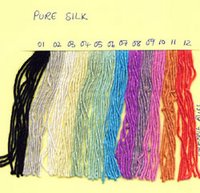
Twelve colors, including a few neutrals, a few brights and a few muted shades. There's a book, Pure Silk 1, devoted to it, with lacy cardigans, the ubiquitous shrug, and other lightweight women's garments.

Debbie Bliss is also introducing a DK-weight version of her Cashmerino -- same composition of merino, microfiber and cashmere, just a DK weight, in 12 colors, mostly brights. She is releasing a second book, called Wish You Were Here, with patterns for men, women & kids in her cotton-containing yarns . Here's a design featuring a cabled back:
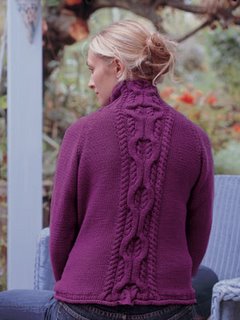
Isn't that gonna dig into her back once she sits down and leans against a chair back?
Another designer whose work I really like is Elsebeth Lavold. My research indicates she is introducing a hemp-based yarn called "Hempathy," and an accompanying book called "Enchanted Garden." Here're two designs from it:


They look kind of plain but it's hard to tell if it's the design or the photography. Hempathy is made of 41% cotton,34% hemp and 25% modal, and comes in about ten colors.
While we're previewing KFI-distributed yarns, let us make a brief stop for Araucania. In addition to last year's introduction, NatureCotton, Araucania is adding the unpronounceable Pehuen, an all-cotton nubbly-looking yarn, about 4.5 st to the inch, in 8 multicolors, and Quellon, 82% viscose/18% cotton, also an aran weight, also about 8 multicolors. I think they're releasing a new Araucania book called "Araucania Moments" (unless it's already out? Email me if you know) and here's a shot of a completely ridiculous top from it:
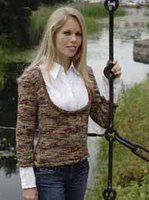
Once her boob implants right themselves, they're gonna zing right up and over the neckline (breastline?) and then we'll see if she's still got that sickly smile on her face.
Finally, let's hear what Eisaku Noro has planned for the spring: Silk Garden Lite -- same composition and self-striping colorways but in a DK-weight, which has me drooling; Tidiori, a 60% rayon/35% nylon/5% cashmere blend, at around worsted weight; and Sakura, 36% rayon/28% polyester/18% nylon/11% silk blend, also around worsted weight.
Quite honestly, I couldn't give a rat's ass what Sirdar, Katia, GGH or Gedifra are doing, and I have no idea WTF Ella Rae is, or why anybody with such a trailer park name has their own line of yarns, so I'm skipping her/it too.
You guys getting all eager to knit up a ... um, viscose tank top?
Yeah, me, too.
Before I plunge into the main event, I want to take a quick minute to call to your attention Wise Needle, a free, nonprofit website that provides yarn information and reviews. Yes, free and yes, nonprofit. It's a great idea and one that benefits us all: free, unbiased information about yarns. If you forget what weight a yarn is, or exactly what fibers it's made of, you can look it up. If you are mulling over a yarn purchase and you've never knit with the stuff before, you can read through reviews that other knitters and crocheters have submitted talking about gauge, quality, wear, and so on. Whenever I remember to, I submit yarn reviews and yarn information, and so I urge you to do so. The more information that is on there, the more we all benefit. No affiliation on my part; just a good on-line resource for us all.
Can Someone Own "Stitch And/&/N Bitch"?
In stark contrast to the community-based, noncommercial, we're-all-in-this-together attitude of Wise Needle stands a little New York sewing shop. This shop (I shan't name it so as not to give it a smidgen of publicity) has started a controversy roiling in the needle arts world concerning a trademark issue. For those of you who, like me, fell asleep when they went over trademark law (as well as social security law, wills, disability law and virtually any other topic that is likely to be even remotely useful to those long-lost relatives of mine who keep asking me for free legal advice. So quit calling already.), a trademark is
Any word, name, symbol, device or any combination thereof adopted and used by a manufacturer or merchant ("person") or any word, name, symbol, device or any combination thereof which the person has a bona fide intention to use in commerce to identify and to distinguish the person's goods from those goods manufactured or sold by others.
The gist of trademark, as it relates to what I'm going to talk about, is that the public knows that any use of a particular phrase is associated with one company. In other words, if you see a computer that is called an "Apple," you know that it comes from that one computer company, the one that invented the Mac and the I-Pod. It doesn't matter if you know the details about who that one computer company is, what they are called -- Apple Computers Inc? some guy named Joe Apple? -- but you have to associate the trademark (Apple) with one single source, and you have to view the trademark as a kind of guarantee of quality -- all Apples are made in a certain way, and any computer with an Apple name on it is made in this way. Other people aren't allowed to call their computers "Apples" because the consumer might confuse them with the original Apple computers.
There are lots of complicated exceptions and modifiers to these general rules, and it's that kind of arcane stuff that I'm not going into. I'll defer to people like The Girl From Auntie for all the gory details.
The controversy that's brewing in the knitting world has to do with whether someone can trademark the phrase "Stitch N Bitch," or "Stitch and Bitch" or "Stitch & Bitch" and in what context. Debbie Stoller's very popular Stitch N Bitch books weren't the first use of the phrase: there is anecdotal evidence that this phrase has been used for a long time to refer to gatherings of women to do needle arts (particularly knitting) while kvetching. (The excellent book "No Idle Hands," which is a history of knitting in America, apparently references this phrase; I can't find my copy so I can't confirm.) But a few years ago, some sewing shop in New York filed for trademark protection on the phrase "Stitch and Bitch Cafe" to refer to their on-line message board.
Since that time, a lot has happened in the knitting world. Debbie Stoller's books were huge. There are, and apparently have long been, groups all over the world who identify themselves as "Stitch N Bitch" clubs and use that phrase in their name, to identify themselves online as Yahoo Groups and in website domain names, on Cafe Press to raise money or market merchandise for their groups, and so on.
And there's the rub.
The NY sewing shop has notified Cafe Press, Yahoo and others that it has a claim for trademark protection and this has caused Cafe Press, Yahoo, etc. to remove any group with "Stitch N Bitch" in its name for fear of legal repercussions. (If you think this is unfair, consider Cafe Press's point of view: someone offers something for sale on the website. Another person complains "hey, their stuff infringes my intellectual property." Cafe Press's position is "Go and fight it out amongst yourselves and leave me out of it. I'm not going to spend time and money listening to your dispute and then make a decision as to who's right, especially when I could be sued if I'm wrong, so I'm taking you all off my site until you settle this yourselves." Sensible, really.)
The reaction of the knitting vox populi is pretty universal: you can't "own" a concept that's been around for years, especially not to refer to your half-ass on-line chat board, so fuck off. I can't imagine that most people in the country have ever heard of this sewing shop, and I certainly don't think consumers are likely to confuse a local S-n-B group with their on-line message board. Maybe my erudite husband will weigh in with a few words, since unlike me, he actually knows about this stuff.
I leave you to make up your own mind about it. If you'd like to read more, just Google "Stitch bitch trademark" or some similar group of phrases, or check out The Girl from Auntie -- she's written extensively and very thoroughly about these issues at various points over time. Do an archive search on her (excellent) website to find some of the older posts.
If you decide you want to contribute to the legal team that is opposing the sewing shop's attempt to fight the trademark, you can visit a Cafe Press store selling "Free to Stitch, Free to Bitch" merchandise here. This website has been publicized by the You Knit What gals; I don't have any specific information about who is running the Cafe Press shop so all the usual rules of caveat emptor apply.
And Now... More Spring Yarn Reviews
I've long been a fan of Debbie Bliss. In fact, one of the first pattern books I purchased when I came back to knitting was an early Debbie Bliss kid's pattern book. The desire to be able to make some of those cute little sweaters was a great motivator for me to keep improving my skills.
For spring 2006, Debbie Bliss is putting out an all-silk, DK-weight silk called "Pure Silk." This one sounds good.

Twelve colors, including a few neutrals, a few brights and a few muted shades. There's a book, Pure Silk 1, devoted to it, with lacy cardigans, the ubiquitous shrug, and other lightweight women's garments.

Debbie Bliss is also introducing a DK-weight version of her Cashmerino -- same composition of merino, microfiber and cashmere, just a DK weight, in 12 colors, mostly brights. She is releasing a second book, called Wish You Were Here, with patterns for men, women & kids in her cotton-containing yarns . Here's a design featuring a cabled back:

Isn't that gonna dig into her back once she sits down and leans against a chair back?
Another designer whose work I really like is Elsebeth Lavold. My research indicates she is introducing a hemp-based yarn called "Hempathy," and an accompanying book called "Enchanted Garden." Here're two designs from it:


They look kind of plain but it's hard to tell if it's the design or the photography. Hempathy is made of 41% cotton,34% hemp and 25% modal, and comes in about ten colors.
While we're previewing KFI-distributed yarns, let us make a brief stop for Araucania. In addition to last year's introduction, NatureCotton, Araucania is adding the unpronounceable Pehuen, an all-cotton nubbly-looking yarn, about 4.5 st to the inch, in 8 multicolors, and Quellon, 82% viscose/18% cotton, also an aran weight, also about 8 multicolors. I think they're releasing a new Araucania book called "Araucania Moments" (unless it's already out? Email me if you know) and here's a shot of a completely ridiculous top from it:

Once her boob implants right themselves, they're gonna zing right up and over the neckline (breastline?) and then we'll see if she's still got that sickly smile on her face.
Finally, let's hear what Eisaku Noro has planned for the spring: Silk Garden Lite -- same composition and self-striping colorways but in a DK-weight, which has me drooling; Tidiori, a 60% rayon/35% nylon/5% cashmere blend, at around worsted weight; and Sakura, 36% rayon/28% polyester/18% nylon/11% silk blend, also around worsted weight.
Quite honestly, I couldn't give a rat's ass what Sirdar, Katia, GGH or Gedifra are doing, and I have no idea WTF Ella Rae is, or why anybody with such a trailer park name has their own line of yarns, so I'm skipping her/it too.
You guys getting all eager to knit up a ... um, viscose tank top?
Yeah, me, too.
Tuesday, January 17, 2006
Spring preview: Rowan
Quick note to readers: I just realized that some of you are actually sending me emails using the blog link to the right. In a rare burst of humility, I hadn't been checking that email address often, so I apologize for anyone who sent an email and waited for a response (thinking, no doubt, what a stuck-up bee-atch I was). I will be checking it more often in the future, so if you've got something to say, and don't want to leave it in the comments, go for it.
By popular demand, I'll continue tantalizing you with hints of things to come. Many knitters, myself included, don't get as breathlessly excited about spring as they do about fall. The weather's getting warmer, not colder, which means less fabric and therefore less knitting. I enjoy some of the special qualities about wool -- its sproinginess and elasticity, most particularly -- that cottons and silks lack. But Rowan is one of my favorite companies, so I look to them most of all to get eager about spring and summer knitting.
Rowan Magazine No. 39 is due out February 1st. Rowan's own website has some previews of their spring designs, organized into three "fashion stories."

The above "Three's Company"-inspired blouse (no, not really) perturbed me for quite a while until I realized it was the bag that was knitted... from the "Provence" collection, garments "from the Mediterranean countryside - beautiful[,] feminine to wear and enjoy."
This cardigan is cute, and if I lose about 35 pounds before April, I plan on making it, dammit. [Hey, stop snickering.]
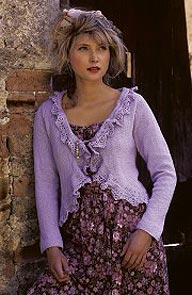
The other "fashion stories" are "Aqua Marine," "inspired by the freshness of the sea," and "Tribal," "dramatic, colourful [and] bold." There are some Kaffe Fassett and Brandon Mably colorwork designs in the latter, for those of you who are fans. I shan't opine as to the silliness of the Brit models in their Maori warpaint or whatever it's supposed to be. I'm sure my commenters will have a field day.
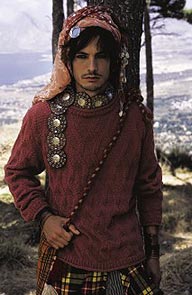
In addition to No. 39, Rowan will be releasing two individual booklets to go with its two new yarns. The Rowan Classic (RYC) line is releasing four new books, one of which is devoted to kids. Rowan must be stingy with its publicity shots, because I couldn't find any on-line previews of these books.
On to yarns.
Rowan broke some hearts when they announced that Cork and Polar were discontinued. They've also discontinued the Rowanspun line (with Yorkshire Tweed and the Scottish Tweed lines, it's easy to see why Rowanspun got the ax) and more relevant to spring knitting, Linen Drape. My research found mention of four new spring yarns, two for Rowan and two for RYC, although information on the 'net is sparse, and I wasn't able to find any photos of the yarns.
Rowan is introducing Holiday, a cotton-viscose blend in eight colors. Holiday is a kind of flat ribbon or tape with a tone-on-tone look (maybe one matte ply, one shiny). Glimmer Print is half cotton and half something else (acetate maybe?), a matte tape with gold shot through.
You can expect to see the still relatively-new Cashsoft Cotton (in DK and 4-ply weights) to be prominent in the Rowan Classic (RYC) line. RYC is also introducing a yarn called Natural Silk Aran, a blend of mostly viscose with silk and linen. There are six colors, muted shades with a ply of cream. Luxury Cotton DK is half cotton blended with viscose and a bit of silk. The palette includes both paler shades and deeper ones, again plying a twist of the matte cotton along with a twist of the shinier viscose/silk.
So there you have it. Apparently, it's going to be the Spring of Viscose as far as Rowan is concerned.
Coming this week: More yarn previews, Adventures in Dyeing, and the Surprise is Revealed (and no, it's not a Chibi cover but that was a good guess).
By popular demand, I'll continue tantalizing you with hints of things to come. Many knitters, myself included, don't get as breathlessly excited about spring as they do about fall. The weather's getting warmer, not colder, which means less fabric and therefore less knitting. I enjoy some of the special qualities about wool -- its sproinginess and elasticity, most particularly -- that cottons and silks lack. But Rowan is one of my favorite companies, so I look to them most of all to get eager about spring and summer knitting.
Rowan Magazine No. 39 is due out February 1st. Rowan's own website has some previews of their spring designs, organized into three "fashion stories."

The above "Three's Company"-inspired blouse (no, not really) perturbed me for quite a while until I realized it was the bag that was knitted... from the "Provence" collection, garments "from the Mediterranean countryside - beautiful[,] feminine to wear and enjoy."
This cardigan is cute, and if I lose about 35 pounds before April, I plan on making it, dammit. [Hey, stop snickering.]

The other "fashion stories" are "Aqua Marine," "inspired by the freshness of the sea," and "Tribal," "dramatic, colourful [and] bold." There are some Kaffe Fassett and Brandon Mably colorwork designs in the latter, for those of you who are fans. I shan't opine as to the silliness of the Brit models in their Maori warpaint or whatever it's supposed to be. I'm sure my commenters will have a field day.

In addition to No. 39, Rowan will be releasing two individual booklets to go with its two new yarns. The Rowan Classic (RYC) line is releasing four new books, one of which is devoted to kids. Rowan must be stingy with its publicity shots, because I couldn't find any on-line previews of these books.
On to yarns.
Rowan broke some hearts when they announced that Cork and Polar were discontinued. They've also discontinued the Rowanspun line (with Yorkshire Tweed and the Scottish Tweed lines, it's easy to see why Rowanspun got the ax) and more relevant to spring knitting, Linen Drape. My research found mention of four new spring yarns, two for Rowan and two for RYC, although information on the 'net is sparse, and I wasn't able to find any photos of the yarns.
Rowan is introducing Holiday, a cotton-viscose blend in eight colors. Holiday is a kind of flat ribbon or tape with a tone-on-tone look (maybe one matte ply, one shiny). Glimmer Print is half cotton and half something else (acetate maybe?), a matte tape with gold shot through.
You can expect to see the still relatively-new Cashsoft Cotton (in DK and 4-ply weights) to be prominent in the Rowan Classic (RYC) line. RYC is also introducing a yarn called Natural Silk Aran, a blend of mostly viscose with silk and linen. There are six colors, muted shades with a ply of cream. Luxury Cotton DK is half cotton blended with viscose and a bit of silk. The palette includes both paler shades and deeper ones, again plying a twist of the matte cotton along with a twist of the shinier viscose/silk.
So there you have it. Apparently, it's going to be the Spring of Viscose as far as Rowan is concerned.
Coming this week: More yarn previews, Adventures in Dyeing, and the Surprise is Revealed (and no, it's not a Chibi cover but that was a good guess).
Sunday, January 15, 2006
You've got to read this book
I just finished reading a new non-fiction book, Self-Made Man, by Norah Vincent. Norah is a respected journalist who has written for the New York Times, the L.A. Times, and the Village Voice, among others. Interestingly, she is generally regarded as a conservative or "right-wing" columnist, and I am generally regarded as a progressive or "liberal" -- but politics, at least the tawdry, Washingtonian kind, aren't at play at all in this book. Full disclosure: Norah's wife Lisa is a friend and frequent commenter here. I've never met Norah (I hope to, but apparently she's going to be spending a lot of time hobnobbing with the likes of Catherine Crier and Stephen Colbert, so she may not have time for small potatoes like me...).
Norah was watching a reality TV show in which contestants dressed in drag and tried to "pass" as the other gender when she had the brilliant idea of exploring what she calls "the deeper sociological implications of passing as the opposite sex." The only way she could do so effectively was to turn into a man. Not permanently, via operation (ouch!) but for an extended period of time, via Ned.

Ned became Norah's male alter ego, for lack of a better phrase. She learned how to dress like a man, how to suppress her obviously female body parts and even more obvious personality traits, how to speak in a more masculine way (both in timbre and in style of speech) and a host of many other things that enabled her to effectively pass as a male, even in intimate settings with other men. Self-Made Man is her thoughtful and entertaining chronicle of what happened next.
It would have been easy for Norah to play this for cheap laughs. But this book ain't a butch version of "Bosom Buddies." Yes, the book is an engrossing read, amusing at times, often laugh-out loud hilarious. Yet Norah repeatedly takes her experiences and applies a powerful intellect, analyzing what her interactions have to say in a larger sense about gender, gender roles and sexuality in turn-of-the-millenium America.
It also would have been easy for Norah to display more of an, well, attitude toward the men and women she encountered during her time as Ned. It is a great credit to her character that she describes the people she met, and often became friends with, in graceful, sensitive and loving terms. She seemed genuinely anguished at having to begin these relationships with deceit and genuinely touched when so many responded to the force and attraction of her personality, no matter what gender it came packaged in.
I had to stop from time to time to reread sentences to admire a particularly well-crafted turn of phrase, or so that I could pause and ponder some of the fascinating points Norah raises. At a few points I even put the book down and let my mind marinate upon it for a longer time -- although I quickly picked the book up again out of selfish eagerness to read more and more.
I'm reminded of a quote from the movie "Tootsie," in which Dustin Hoffman tells Jessica Lange "[I] was a better man with you as a woman, then I ever was with a woman as a man." What is so fascinating about Self-Made Man is that we see how the men Ned interacted with became better men with Ned as a woman, and how Norah became a better woman after spending time as a man.
Norah was watching a reality TV show in which contestants dressed in drag and tried to "pass" as the other gender when she had the brilliant idea of exploring what she calls "the deeper sociological implications of passing as the opposite sex." The only way she could do so effectively was to turn into a man. Not permanently, via operation (ouch!) but for an extended period of time, via Ned.

Ned became Norah's male alter ego, for lack of a better phrase. She learned how to dress like a man, how to suppress her obviously female body parts and even more obvious personality traits, how to speak in a more masculine way (both in timbre and in style of speech) and a host of many other things that enabled her to effectively pass as a male, even in intimate settings with other men. Self-Made Man is her thoughtful and entertaining chronicle of what happened next.
It would have been easy for Norah to play this for cheap laughs. But this book ain't a butch version of "Bosom Buddies." Yes, the book is an engrossing read, amusing at times, often laugh-out loud hilarious. Yet Norah repeatedly takes her experiences and applies a powerful intellect, analyzing what her interactions have to say in a larger sense about gender, gender roles and sexuality in turn-of-the-millenium America.
It also would have been easy for Norah to display more of an, well, attitude toward the men and women she encountered during her time as Ned. It is a great credit to her character that she describes the people she met, and often became friends with, in graceful, sensitive and loving terms. She seemed genuinely anguished at having to begin these relationships with deceit and genuinely touched when so many responded to the force and attraction of her personality, no matter what gender it came packaged in.
I had to stop from time to time to reread sentences to admire a particularly well-crafted turn of phrase, or so that I could pause and ponder some of the fascinating points Norah raises. At a few points I even put the book down and let my mind marinate upon it for a longer time -- although I quickly picked the book up again out of selfish eagerness to read more and more.
I'm reminded of a quote from the movie "Tootsie," in which Dustin Hoffman tells Jessica Lange "[I] was a better man with you as a woman, then I ever was with a woman as a man." What is so fascinating about Self-Made Man is that we see how the men Ned interacted with became better men with Ned as a woman, and how Norah became a better woman after spending time as a man.
Tuesday, January 10, 2006
Some Finished Projects (finally)
Okay, that last entry took a lot out of me. While I muster up enough mental energy for my next substantive post, let's do a quickie knitting-related recap.
Free On-Line Patterns for Guys
The new MenKnit on-line magazine is up. Free patterns in PDF form for the men in your life (although some could very easily be knitted up for women, too). You can click on the nifty sweatered chap and then scroll down to find the PDF download button. My Faux Fair Isle cap is in this issue, modeled by James and Tom.

Of course, the hats in the above photo are not being modeled by James and Tom, but you knew that I wasn't married to a styrofoam head, didn't you? (although sometimes when he's engrossed in the New York Times and studiously ignoring my calls, I have to wonder)
Finished Project
The Minnie Mae dog jacket is officially finished.

I hope to get a photo of Minnie Mae herself modeling the jacket; however, this will require me actually packaging it up and mailing it out in the near future (along with Kat's "Ro-o-ger" prize, which I haven't forgotten). I also found a very cute pink leather (yes, pink!) leash at Lands' End for the Minnster, so a nice if belated Christmas package will be on its way soon.
The Jil Eaton Puppyknits pattern was very clear and easy to follow, by the way. Her patterns generally are, in my experience. Plymouth Encore was the perfect yarn for this project: economical, machine washable, brightly-colored.
Call for Caps
During the past few weeks, I finished a batch of kids' caps in warm wools.

I find knitting caps to be very soothing. If I have projects which are going slowly or giving me trouble, or I just don't have uninterrupted time to focus on a more complex project, I can pick up a cap and knit in the round for a while. Caps are so easy to make and they finish up quickly, especially when you use a bulkier weight of yarn. I generally make my kids hats each year in the favored colors or to match coats, so after that I like to send them somewhere where some chilly little kid will be able to use them. These are headed to Afghans for Afghans, a great group which sends warm items like caps and blankets to Afghanistan, a sort of cross-cultural thing. If you happen to be interested, they are issuing a call for 500 warm wool caps by January 20th. Somehow they got access to airplane transport for a limited amount of items, so they are pushing for donations of 500 handknit or crocheted caps. Info's on their website. I throw that out there for anyone who's interested and hasn't heard about it.
Mystery Project
What is this strange little item?

Is it a knitted penis, fresh from a mad fiber-crafter's Bobbitectomy?
No, it is not.
It is, in fact, part of a surprise I am making for someone who reads this very blog regularly. Be patient, gentle readers; all will be revealed in due time.
Coming this week: My First Annual Statistical Analysis of Herrschner's Catalog, and a spring yarn sneak preview...
Free On-Line Patterns for Guys
The new MenKnit on-line magazine is up. Free patterns in PDF form for the men in your life (although some could very easily be knitted up for women, too). You can click on the nifty sweatered chap and then scroll down to find the PDF download button. My Faux Fair Isle cap is in this issue, modeled by James and Tom.

Of course, the hats in the above photo are not being modeled by James and Tom, but you knew that I wasn't married to a styrofoam head, didn't you? (although sometimes when he's engrossed in the New York Times and studiously ignoring my calls, I have to wonder)
Finished Project
The Minnie Mae dog jacket is officially finished.

I hope to get a photo of Minnie Mae herself modeling the jacket; however, this will require me actually packaging it up and mailing it out in the near future (along with Kat's "Ro-o-ger" prize, which I haven't forgotten). I also found a very cute pink leather (yes, pink!) leash at Lands' End for the Minnster, so a nice if belated Christmas package will be on its way soon.
The Jil Eaton Puppyknits pattern was very clear and easy to follow, by the way. Her patterns generally are, in my experience. Plymouth Encore was the perfect yarn for this project: economical, machine washable, brightly-colored.
Call for Caps
During the past few weeks, I finished a batch of kids' caps in warm wools.

I find knitting caps to be very soothing. If I have projects which are going slowly or giving me trouble, or I just don't have uninterrupted time to focus on a more complex project, I can pick up a cap and knit in the round for a while. Caps are so easy to make and they finish up quickly, especially when you use a bulkier weight of yarn. I generally make my kids hats each year in the favored colors or to match coats, so after that I like to send them somewhere where some chilly little kid will be able to use them. These are headed to Afghans for Afghans, a great group which sends warm items like caps and blankets to Afghanistan, a sort of cross-cultural thing. If you happen to be interested, they are issuing a call for 500 warm wool caps by January 20th. Somehow they got access to airplane transport for a limited amount of items, so they are pushing for donations of 500 handknit or crocheted caps. Info's on their website. I throw that out there for anyone who's interested and hasn't heard about it.
Mystery Project
What is this strange little item?

Is it a knitted penis, fresh from a mad fiber-crafter's Bobbitectomy?
No, it is not.
It is, in fact, part of a surprise I am making for someone who reads this very blog regularly. Be patient, gentle readers; all will be revealed in due time.
Coming this week: My First Annual Statistical Analysis of Herrschner's Catalog, and a spring yarn sneak preview...
Friday, January 06, 2006
A Very Special New Year's Treat: The Lost Curious George Book
Imagine my delight when my children and I stumbled across this very rare Curious George book in a dusty trunk in the corner of the attic. I hope you enjoy it as much as we did.
Curious George Goes To A Brothel (with sincere apologies to H.M. Rey)
This is George.
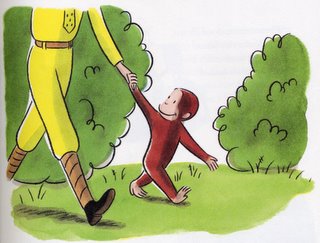
George was a good little monkey and always very curious. One day, the man with the yellow hat had a surprise for George. "We're going to find some hos, George," said the man. George was not quite sure what "hos" were. Were hos good to eat, like chocolate candies?

Were hos fun to play with, like a new ball? George hoped so. He followed the man with the yellow hat out to the blue car.
The man with the yellow hat drove with George to a part of town that George had not seen before.
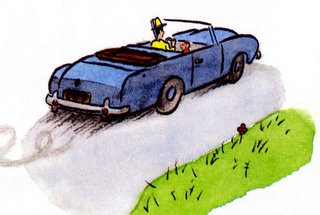
They stopped on a dark street, in front of a very big house with a red light glowing out front. George wanted to stay and look at the light -- was there a fire truck coming? -- but the man with the yellow hat hurried him inside.
"Stay right here, George," said the man. "And please, don't touch anyone--er, anything and don't get into any trouble!"
George sat down and looked around him. He had never seen such a fancy room before. There were rugs that felt soft between his toes, and long velvet drapes, and red sofas covered in velvet.
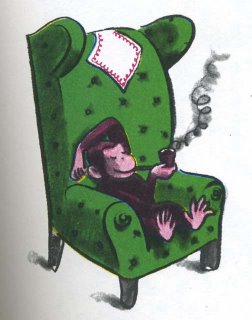
"Hey sailor! Is that a banana in your pocket or are you just happy to see me?"
George looked up. It was his old friend Betsy! George was happy to see her. George climbed up the sofa and jumped onto the chandelier (monkeys are good at jumping). He was just about to hop into Betsy's lap when the door opened and a mean-looking lady hurried into the room. "Get down from my frickin' chandelier, you &*$%&*# bag of fleas!" she said to George.
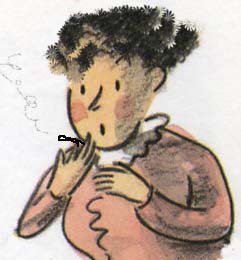
George did not understand exactly what the lady meant, but he knew she was angry. He swung down and scampered behind a sofa. Would the mean lady see him there? No, she would not. When the lady couldn't find George, she muttered more words George did not understand and went outside to smoke a cigarette.
George was happy that the mean lady was gone. He tried very hard to sit quietly on the sofa and stay out of trouble, but it is easy for little monkeys to forget. Suddenly George heard a noise coming from behind a door.

George was curious. What was making that rhythmic banging noise? George moved closer to the door. Now he heard a lady saying, "Oh, oh, oh." The lady must be in trouble, George thought, and he opened the door to see if he could help.
It was George's old friend, the Mayor!
But the Mayor did not look happy to see George. And why were his pants down around his ankles? "My re-election campaign!" said the Mayor. "It's ruined!" As quick as a wink, the Mayor pulled up his pants and came running after George.
George felt bad. He had not meant to surprise the Mayor and his friend. He thought the moaning lady was in trouble and only wanted to help. And he hadn't meant to ruin the Mayor's "re-election campaign," although George wasn't sure what that was. But the Mayor looked quite angry. Would he put George in jail? Would he send George back to the jungle? George did not want to wait to find out.
George ran down the hallway.
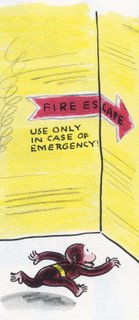
He saw a door at the end of the passageway, so he pushed it open. It led to a back alleyway. George quickly slipped through the door -- but wait! What was that buzzing sound?
George had set off the emergency exit alarm!
George hid behind a garbage can. What a scary day this had been! George had just decided that trying to find hos was not a treat at all, when he noticed all sorts of people running through the back door he had opened. There was the Mayor, and the mean lady with the cigarette, and Betsy, and the man with the yellow hat.
At the same instant, George heard the sound of police sirens. He peeked around the garbage can and saw five police cars pull up to the front of the house. What fun! George loved police cars. George slipped out from behind the can so he could watch. He heard a policeman yell "This is a raid!"

George saw the Mayor's eyes get very wide as he, too, saw the police cars. Then the man with the yellow hat saw George. "There you are, you little monkey," said the man with the yellow hat, with a very stern look on his face.
"Hold on," said the Mayor. The Mayor was smiling down at George, a kindly twinkle in his eye. "You may have opened my door at the worst possible time, but you got me out of that place just before a police raid! My re-election campaign is saved!" The Mayor shook George's hand.

George was happy that he could help the Mayor. As the man with the yellow hat drove them home, George decided that he would rather have ice cream than hos any day.

The End.
Curious George Goes To A Brothel (with sincere apologies to H.M. Rey)
This is George.

George was a good little monkey and always very curious. One day, the man with the yellow hat had a surprise for George. "We're going to find some hos, George," said the man. George was not quite sure what "hos" were. Were hos good to eat, like chocolate candies?

Were hos fun to play with, like a new ball? George hoped so. He followed the man with the yellow hat out to the blue car.
The man with the yellow hat drove with George to a part of town that George had not seen before.

They stopped on a dark street, in front of a very big house with a red light glowing out front. George wanted to stay and look at the light -- was there a fire truck coming? -- but the man with the yellow hat hurried him inside.
"Stay right here, George," said the man. "And please, don't touch anyone--er, anything and don't get into any trouble!"
George sat down and looked around him. He had never seen such a fancy room before. There were rugs that felt soft between his toes, and long velvet drapes, and red sofas covered in velvet.

"Hey sailor! Is that a banana in your pocket or are you just happy to see me?"
George looked up. It was his old friend Betsy! George was happy to see her. George climbed up the sofa and jumped onto the chandelier (monkeys are good at jumping). He was just about to hop into Betsy's lap when the door opened and a mean-looking lady hurried into the room. "Get down from my frickin' chandelier, you &*$%&*# bag of fleas!" she said to George.

George did not understand exactly what the lady meant, but he knew she was angry. He swung down and scampered behind a sofa. Would the mean lady see him there? No, she would not. When the lady couldn't find George, she muttered more words George did not understand and went outside to smoke a cigarette.
George was happy that the mean lady was gone. He tried very hard to sit quietly on the sofa and stay out of trouble, but it is easy for little monkeys to forget. Suddenly George heard a noise coming from behind a door.

George was curious. What was making that rhythmic banging noise? George moved closer to the door. Now he heard a lady saying, "Oh, oh, oh." The lady must be in trouble, George thought, and he opened the door to see if he could help.
It was George's old friend, the Mayor!
But the Mayor did not look happy to see George. And why were his pants down around his ankles? "My re-election campaign!" said the Mayor. "It's ruined!" As quick as a wink, the Mayor pulled up his pants and came running after George.
George felt bad. He had not meant to surprise the Mayor and his friend. He thought the moaning lady was in trouble and only wanted to help. And he hadn't meant to ruin the Mayor's "re-election campaign," although George wasn't sure what that was. But the Mayor looked quite angry. Would he put George in jail? Would he send George back to the jungle? George did not want to wait to find out.
George ran down the hallway.

He saw a door at the end of the passageway, so he pushed it open. It led to a back alleyway. George quickly slipped through the door -- but wait! What was that buzzing sound?
George had set off the emergency exit alarm!
George hid behind a garbage can. What a scary day this had been! George had just decided that trying to find hos was not a treat at all, when he noticed all sorts of people running through the back door he had opened. There was the Mayor, and the mean lady with the cigarette, and Betsy, and the man with the yellow hat.
At the same instant, George heard the sound of police sirens. He peeked around the garbage can and saw five police cars pull up to the front of the house. What fun! George loved police cars. George slipped out from behind the can so he could watch. He heard a policeman yell "This is a raid!"

George saw the Mayor's eyes get very wide as he, too, saw the police cars. Then the man with the yellow hat saw George. "There you are, you little monkey," said the man with the yellow hat, with a very stern look on his face.
"Hold on," said the Mayor. The Mayor was smiling down at George, a kindly twinkle in his eye. "You may have opened my door at the worst possible time, but you got me out of that place just before a police raid! My re-election campaign is saved!" The Mayor shook George's hand.

George was happy that he could help the Mayor. As the man with the yellow hat drove them home, George decided that he would rather have ice cream than hos any day.

The End.
Thursday, January 05, 2006
And the ultimate book to anticipate eagerly in 2006:
our own Knitting Curmudgeon's opus magnificum

the first chapter of which I have already read, and I can tell you: it's mah-velous!

the first chapter of which I have already read, and I can tell you: it's mah-velous!
Wednesday, January 04, 2006
Upcoming treats: 2006 Book Preview
Oh, how I loves books. Oh, how I loves knitting. Oh, how I lo-o-o-o-oves books about knitting. So to keep me happier than a pig in poop, here's a preview of some of the knitting books that are scheduled to come out during the first half of 2006.
As a quick aside, long-time commenter Anonymous noted that my yarn cost-comparison did not account for the "instant gratification [of] leaving the store w/ yarn." Yes, it's true that there is great joy in swinging a paper bag full of fabulous yarn back and forth as you walk out a yarn shop door, but there is just as much joy for me in expecting a package. The eager glancing at the clock, waiting for the sound of the UPS door sliding open or the postman's little truck, slitting open the box, plunging your hands in to see the new treasures...it's the same mentality that makes Christmas Eve more fun for me than Christmas Day. Some of the following will, undoubtedly, arrive on my doorstep to bated breath in an Amazon.com box.
One of the books I'm eagerly anticipating is Inspired Cable Knits, by Fiona Ellis, due mid-February.
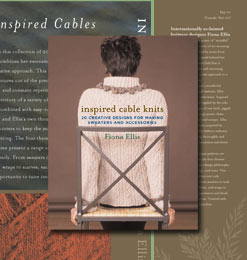
Twenty designs (which is a lot, considering they are all using cables of some sort) by Fiona Ellis, a British designer published in IK, VK, and others. Let's hear it for non-dumbed-down knitting (we hope)!
I suspect Vogue's Stichionary Two (May) will also be a keeper. I've just gotten the first one, and it looks quite useful. (Note to users: I've heard rumblings of some errors in the patterns but haven't personally found any yet, so keep your eyes open for an errata.) You've heard me expound on the value of stitch treasuries before. I do realize that owning one kick-ass stitch treasury can get you a long way (and I have Barbara Walker and Harmony), but I never balk at getting new ones. As I said before, even a minor change in a pattern or stitch count can sometimes make inspiration pop in my mind. Vogue's volume 2 is devoted to cable stitches. From the looks of the cover, the stitches will all be modeled in brown yarn, which may not be the best choice depending on how dark the color is. You may have noticed that some of the green yarns used in the first book don't showcase the stitch patterns to their best advantage, so here's a plea to Trisha Malcolm (she isn't returning my phone messages, the bee-atch): how about, say, light gray yarn for volume 3?
Apparently the word "funky" is still considered a ticket to getting supposedly hip folks to buy knitting books. We've got Funky Chunky Knitted Accessories from Jan Eaton and Funky Knits: Knitting Know-How for Hip Young Things (icky title, innit?) by Carol Meldrum. I might be tempted to take a look at the former, since Jan Eaton's two books on knitted afghan blocks are interesting (and look for a third, on ripple stitches, coming in March), except the publicity shot I found on Martingale's website
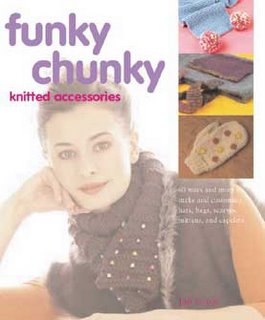
looks unimpressive. See that mitten over there on the right? Doesn't it look an awful lot like an oven mitt? Seems to me that accessories don't take that long to knit anyway, so they don't really need to be that chunky to be funky, and may instead look clunky. Being neither hip nor young, nor in need of funky knitting know-how, I shall skip entirely the Meldrum title.
Nicki Epstein's got Knitted Flowers about to bloom. This is another one I'll have to look through before purchasing; I'm just not sure I need an entire book of knitted flowers for embellishment (can you say tschotschk-o-rama?), but I've got an open mind, seeing how useful her Embellishments and On the Edge books have proved to be. I thought I read something somewhere about her also releasing a felted bags book, but I can't find any reference to it on the internet, so maybe I made that up.
Knitting Out of Africa, by Marianne Isager -- If I am not mistaken, our own blogger QueerJoe owns this book in the original Danish. It's being released in translation by Interweave Press. The book finds inspiration in African baskets and textiles and the designs incorporate a variety of techniques -- stranded knitting, domino knitting, intarsia, and more.
The cover for Knitting With Ribbon Yarn by Rowan designer Tracy Chapman (who I assume does not have a "Fast Car"), looks intriguing, and this is a subject I think hasn't been explored adequately. Other than scarves and tank tops, I'd like to see some real thought given to the unique properties of ribbons of different kinds, and how to showcase them. This book is being released by Trafalgar Square, an imprint which has published a lot of Rowan designers (including Debbie Bliss), which is a good sign.
Getting Started Knitting by Jennifer Worick is a book I'll definitely buy. Not because I really need another beginner's book, but because I know the folks who did the project designs and having seen some of the designs on the needles, I suspect the book will be worth it for the patterns.
One-Skein Knitting, by Leigh Radford, is another idea whose time has come. Who hasn't got a spare ball of some kind laying around, whether intended for a project later abandoned, or left over from a larger project, or something that appealed because of color or texture or softness, but now sits unexplored because you're sick of scarves, scarves, scarves?
Stephanie Pearl-McPhee fans should look for Knitting Rules,

out around March 1st. I was fortunate enough to meet the blogosphere's own Yarn Harlot when Stephanie signed books at Rosie's Stitches East booth, and she's as funny and delightful in person as she is on her blog.
Last but not least is Big Girl Knits, by Amy Singer and Jillian Moreno, out in April.
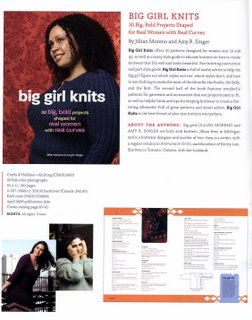
Dedicated readers will know, perhaps stifling ennui or frustration that I'm mentioning it again!, that I have a pattern in this book. As my first published-in-an-Amazon.com-type-book pattern, this fills me with tremendous pride and excitement. I do, however, think that this book is likely to be a winner apart from (or do I mean "notwithstanding"?) my meager contribution. Amy and Jillian worked very hard to create a book which does three things for plus-sized knitters: (1) gives them patterns in an extended range of sizes, (2) makes those patterns contemporary, stylish and body-conscious, rather than flowing tunics to try to hide curves, and (3) makes the garments customizable to fit differing body types.
Let me know if you'd like me to do more previews, and I'll update as more titles are slated for release. And if there's anything else you'd like me to opine on (say, spring yarn previews?), let me know, too.
Because you, my dear readers, are so very special to me.
As a quick aside, long-time commenter Anonymous noted that my yarn cost-comparison did not account for the "instant gratification [of] leaving the store w/ yarn." Yes, it's true that there is great joy in swinging a paper bag full of fabulous yarn back and forth as you walk out a yarn shop door, but there is just as much joy for me in expecting a package. The eager glancing at the clock, waiting for the sound of the UPS door sliding open or the postman's little truck, slitting open the box, plunging your hands in to see the new treasures...it's the same mentality that makes Christmas Eve more fun for me than Christmas Day. Some of the following will, undoubtedly, arrive on my doorstep to bated breath in an Amazon.com box.
One of the books I'm eagerly anticipating is Inspired Cable Knits, by Fiona Ellis, due mid-February.

Twenty designs (which is a lot, considering they are all using cables of some sort) by Fiona Ellis, a British designer published in IK, VK, and others. Let's hear it for non-dumbed-down knitting (we hope)!
I suspect Vogue's Stichionary Two (May) will also be a keeper. I've just gotten the first one, and it looks quite useful. (Note to users: I've heard rumblings of some errors in the patterns but haven't personally found any yet, so keep your eyes open for an errata.) You've heard me expound on the value of stitch treasuries before. I do realize that owning one kick-ass stitch treasury can get you a long way (and I have Barbara Walker and Harmony), but I never balk at getting new ones. As I said before, even a minor change in a pattern or stitch count can sometimes make inspiration pop in my mind. Vogue's volume 2 is devoted to cable stitches. From the looks of the cover, the stitches will all be modeled in brown yarn, which may not be the best choice depending on how dark the color is. You may have noticed that some of the green yarns used in the first book don't showcase the stitch patterns to their best advantage, so here's a plea to Trisha Malcolm (she isn't returning my phone messages, the bee-atch): how about, say, light gray yarn for volume 3?
Apparently the word "funky" is still considered a ticket to getting supposedly hip folks to buy knitting books. We've got Funky Chunky Knitted Accessories from Jan Eaton and Funky Knits: Knitting Know-How for Hip Young Things (icky title, innit?) by Carol Meldrum. I might be tempted to take a look at the former, since Jan Eaton's two books on knitted afghan blocks are interesting (and look for a third, on ripple stitches, coming in March), except the publicity shot I found on Martingale's website

looks unimpressive. See that mitten over there on the right? Doesn't it look an awful lot like an oven mitt? Seems to me that accessories don't take that long to knit anyway, so they don't really need to be that chunky to be funky, and may instead look clunky. Being neither hip nor young, nor in need of funky knitting know-how, I shall skip entirely the Meldrum title.
Nicki Epstein's got Knitted Flowers about to bloom. This is another one I'll have to look through before purchasing; I'm just not sure I need an entire book of knitted flowers for embellishment (can you say tschotschk-o-rama?), but I've got an open mind, seeing how useful her Embellishments and On the Edge books have proved to be. I thought I read something somewhere about her also releasing a felted bags book, but I can't find any reference to it on the internet, so maybe I made that up.
Knitting Out of Africa, by Marianne Isager -- If I am not mistaken, our own blogger QueerJoe owns this book in the original Danish. It's being released in translation by Interweave Press. The book finds inspiration in African baskets and textiles and the designs incorporate a variety of techniques -- stranded knitting, domino knitting, intarsia, and more.
The cover for Knitting With Ribbon Yarn by Rowan designer Tracy Chapman (who I assume does not have a "Fast Car"), looks intriguing, and this is a subject I think hasn't been explored adequately. Other than scarves and tank tops, I'd like to see some real thought given to the unique properties of ribbons of different kinds, and how to showcase them. This book is being released by Trafalgar Square, an imprint which has published a lot of Rowan designers (including Debbie Bliss), which is a good sign.
Getting Started Knitting by Jennifer Worick is a book I'll definitely buy. Not because I really need another beginner's book, but because I know the folks who did the project designs and having seen some of the designs on the needles, I suspect the book will be worth it for the patterns.
One-Skein Knitting, by Leigh Radford, is another idea whose time has come. Who hasn't got a spare ball of some kind laying around, whether intended for a project later abandoned, or left over from a larger project, or something that appealed because of color or texture or softness, but now sits unexplored because you're sick of scarves, scarves, scarves?
Stephanie Pearl-McPhee fans should look for Knitting Rules,

out around March 1st. I was fortunate enough to meet the blogosphere's own Yarn Harlot when Stephanie signed books at Rosie's Stitches East booth, and she's as funny and delightful in person as she is on her blog.
Last but not least is Big Girl Knits, by Amy Singer and Jillian Moreno, out in April.

Dedicated readers will know, perhaps stifling ennui or frustration that I'm mentioning it again!, that I have a pattern in this book. As my first published-in-an-Amazon.com-type-book pattern, this fills me with tremendous pride and excitement. I do, however, think that this book is likely to be a winner apart from (or do I mean "notwithstanding"?) my meager contribution. Amy and Jillian worked very hard to create a book which does three things for plus-sized knitters: (1) gives them patterns in an extended range of sizes, (2) makes those patterns contemporary, stylish and body-conscious, rather than flowing tunics to try to hide curves, and (3) makes the garments customizable to fit differing body types.
Let me know if you'd like me to do more previews, and I'll update as more titles are slated for release. And if there's anything else you'd like me to opine on (say, spring yarn previews?), let me know, too.
Because you, my dear readers, are so very special to me.
Sunday, January 01, 2006
Thud. (The sound of another sacred cow falling.)
What do you call a middle-aged guy who dresses in sequins, feathers and glitter; applies copious amounts of makeup to his face; and shakes his ass up and down the middle of the main street of town?
A transvestite prostitute?
Maybe. But if you live in Philadelphia, and it's New Year's Day, you might call him a Mummer.
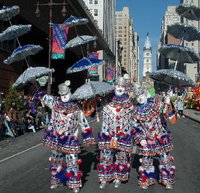
For those of my readers who've never heard of the Mummers, you can check out the official website here, or to quote a National Geographic article:
They’re called Mummers (probably after the German word for disguise)—thousands of mostly white blue-collar guys who nearly every January 1 since 1901 have paraded through the city in wild array from head to spray-painted toe.
The origins of the Mummers are rooted in history but nobody really agrees how far back dates the New Year's Day tradition of getting dressed up in wild costumes and playing in bands while marching down the main drag (and I do mean drag) of Philadelphia. Swedish New Year's celebrations? English re-enactments of St. George and the Dragon? Medieval Christian mystery plays? Who knows? Who cares?
My dirty little secret: I just don't get Mummers.
Now I love Philadelphia. I have more affection and loyalty to this, my adopted city, than I ever felt for the town in which I grew up. Tastykakes, soft pretzels and cheesesteaks? Love 'em. Independence Hall still gives me chills. Boathouse Row, the cobbled streets of Chestnut Hill, people-watching at Rittenhouse Square, history and culture and architecture and so much more. I'm diligently working on my Philly accent (the hallmark of which is the long "o" pronounced like this: round your lips the normal way but say "ew". "Coo-ew--ke." "Ho-ew-agie.") I know that it's Pash-a-yunk, not "Pass-ee-yunk" and I was even willing to watch the moderately bad TV show "Hack" in order to enjoy the backshots of our faire city. But Mummery?
No, thanks.
Mummers face a nearly insurmountable hurdle by the fact that they strut their stuff on New Year's Day, in the morning. I don't have to spell it out for you, do I? Hangovers? Getting up at the crack of dawn? Standing on a street corner in the middle of winter for hours, with no bathroom in sight and some other hungover sap breathing vile fermented beer breath down your back while sitting in the lawn chair he put there to save his place ten hours ago? That's enough to ruin it for me right there.
Mummery gets a second, nearly fatal blow from the disturbing associations it presents. "Mummer" sounds suspiciously like Mummenschanz. If Mummenschanz doesn't creep you out, then you're reading the wrong blog, my friend. Moreover, a mummer is, when you look at it, really just a sparklier, glorified clown. Was it Jay Leno who called clowns "anthrax-ridden entertainment from the fifteenth century?" I would not go so far as to say clowns scare me, but I don't really like them. They don't make me feel happy or jolly: instead I find them vaguely disturbing and irritating, and have an uncontrollable urge to shove that poodle made of tied weiner balloons up their polka-dotted asses.
It may also have to do with my musical tastes. I'm not a big ukelele kind of gal. And hearing a tinny version of "Oh Dem Golden Slippers" on a banjo isn't my idea of musical paradise.
Probably most of it, however are certain cultural assumptions that I make. I can't help feeling that much of this mummery business is just an excuse for Fred Flintstone and Barney Rubble to get out of the house and away from their (nagging, castrating harridans they call) wives and (whining, demanding) kids for a couple of hours every day. A way for the good ole boys to play in their treehouse -- no girls allowed, just like Spanky and Alfalfa. A place where manly men can drink beer and enjoy fart jokes and talk about how little sex their wives want to have with them, while scratching their pot bellies through their Eagles--I mean, Iggles-- T-shirts.
And some of it is the inescapable irony that these same guys who would no doubt beat the crap out of a man at a bar for seeming overly effeminate, or who firmly believe "homos" shouldn't be allowed to march in the St. Patrick's Day Parade, spend so much time, money and attention acting like the biggest bunch of drag queens on January 1st each year. (Although I suspect most self-respecting drag queens wouldn't be caught dead in those Bozo-meets-Uncle-Sam outfits.)
Philadelphia, I'll keep.
But you can have the Mummers.
No give-backs.
A transvestite prostitute?
Maybe. But if you live in Philadelphia, and it's New Year's Day, you might call him a Mummer.

For those of my readers who've never heard of the Mummers, you can check out the official website here, or to quote a National Geographic article:
They’re called Mummers (probably after the German word for disguise)—thousands of mostly white blue-collar guys who nearly every January 1 since 1901 have paraded through the city in wild array from head to spray-painted toe.
The origins of the Mummers are rooted in history but nobody really agrees how far back dates the New Year's Day tradition of getting dressed up in wild costumes and playing in bands while marching down the main drag (and I do mean drag) of Philadelphia. Swedish New Year's celebrations? English re-enactments of St. George and the Dragon? Medieval Christian mystery plays? Who knows? Who cares?
My dirty little secret: I just don't get Mummers.
Now I love Philadelphia. I have more affection and loyalty to this, my adopted city, than I ever felt for the town in which I grew up. Tastykakes, soft pretzels and cheesesteaks? Love 'em. Independence Hall still gives me chills. Boathouse Row, the cobbled streets of Chestnut Hill, people-watching at Rittenhouse Square, history and culture and architecture and so much more. I'm diligently working on my Philly accent (the hallmark of which is the long "o" pronounced like this: round your lips the normal way but say "ew". "Coo-ew--ke." "Ho-ew-agie.") I know that it's Pash-a-yunk, not "Pass-ee-yunk" and I was even willing to watch the moderately bad TV show "Hack" in order to enjoy the backshots of our faire city. But Mummery?
No, thanks.
Mummers face a nearly insurmountable hurdle by the fact that they strut their stuff on New Year's Day, in the morning. I don't have to spell it out for you, do I? Hangovers? Getting up at the crack of dawn? Standing on a street corner in the middle of winter for hours, with no bathroom in sight and some other hungover sap breathing vile fermented beer breath down your back while sitting in the lawn chair he put there to save his place ten hours ago? That's enough to ruin it for me right there.
Mummery gets a second, nearly fatal blow from the disturbing associations it presents. "Mummer" sounds suspiciously like Mummenschanz. If Mummenschanz doesn't creep you out, then you're reading the wrong blog, my friend. Moreover, a mummer is, when you look at it, really just a sparklier, glorified clown. Was it Jay Leno who called clowns "anthrax-ridden entertainment from the fifteenth century?" I would not go so far as to say clowns scare me, but I don't really like them. They don't make me feel happy or jolly: instead I find them vaguely disturbing and irritating, and have an uncontrollable urge to shove that poodle made of tied weiner balloons up their polka-dotted asses.
It may also have to do with my musical tastes. I'm not a big ukelele kind of gal. And hearing a tinny version of "Oh Dem Golden Slippers" on a banjo isn't my idea of musical paradise.
Probably most of it, however are certain cultural assumptions that I make. I can't help feeling that much of this mummery business is just an excuse for Fred Flintstone and Barney Rubble to get out of the house and away from their (nagging, castrating harridans they call) wives and (whining, demanding) kids for a couple of hours every day. A way for the good ole boys to play in their treehouse -- no girls allowed, just like Spanky and Alfalfa. A place where manly men can drink beer and enjoy fart jokes and talk about how little sex their wives want to have with them, while scratching their pot bellies through their Eagles--I mean, Iggles-- T-shirts.
And some of it is the inescapable irony that these same guys who would no doubt beat the crap out of a man at a bar for seeming overly effeminate, or who firmly believe "homos" shouldn't be allowed to march in the St. Patrick's Day Parade, spend so much time, money and attention acting like the biggest bunch of drag queens on January 1st each year. (Although I suspect most self-respecting drag queens wouldn't be caught dead in those Bozo-meets-Uncle-Sam outfits.)
Philadelphia, I'll keep.
But you can have the Mummers.
No give-backs.
